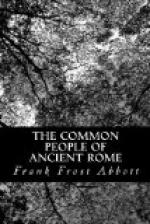Here is a sentiment which sounds very modern:
“The common opinion
is this:
That property should be divided."[76]
This touch of modernity reminds one of another group of verses which brings antiquity into the closest possible touch with some present-day practices. The Romans, like ourselves, were great travellers and sightseers, and the marvels of Egypt in particular appealed to them, as they do to us, with irresistible force. Above all, the great statue of Memnon, which gave forth a strange sound when it was struck by the first rays of the rising sun, drew travellers from far and near. Those of us who know the Mammoth Cave, Niagara Falls, the Garden of the Gods, or some other of our natural wonders, will recall how fond a certain class of visitors are of immortalizing themselves by scratching their names or a sentiment on the walls or the rocks which form these marvels. Such inscriptions We find on the temple walls in Egypt—three of them appear on the statue of Memnon, recording in verse the fact that the writers had visited the statue and heard the voice of the god at sunrise. One of these Egyptian travellers, a certain Roman lady journeying up the Nile, has scratched these verses on a wall of the temple at Memphis:[77]
“The pyramids without
thee have I seen,
My brother sweet, and yet,
as tribute sad,
The bitter tears have poured
adown my cheek,
And sadly mindful of thy absence
now
I chisel here this melancholy
note.”
Then follow the name and titles of the absent brother, who is better known to posterity from these scribbled lines of a Cook’s tourist than from any official records which have come down to us. All of these pieces of popular poetry which we have been discussing thus far were engraved on stone, bronze, stucco, or on some other durable material. A very few bits of this kind of verse, from one to a half dozen lines in length, have come down to us in literature. They have the unique distinction, too, of being specimens of Roman folk poetry, and some of them are found in the most unlikely places. Two of them are preserved by a learned commentator on the Epistles of Horace. They carry us back to our school-boy days. When we read
“The plague take him who’s last to reach me,"[78]
we can see the Roman urchin standing in the market-place, chanting the magic formula, and opposite him the row of youngsters on tiptoe, each one waiting for the signal to run across the intervening space and be the first to touch their comrade. What visions of early days come back to us—days when we clasped hands in a circle and danced about one or two children placed in the centre of the ring, and chanted in unison some refrain, upon reading in the same commentator to Horace a ditty which runs:[79]
“King shall you be
If you do well.
If you do ill
You shall not be.”




